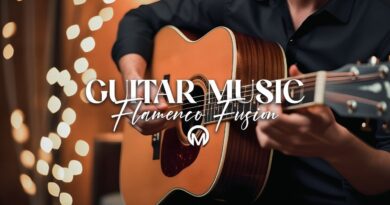Review: Yamaha CG172SF ** Flamenco Guitar Vs Classical Guitar ** Is There A Difference?
Reviewing The Yamaha CG172SF. It’s not a classical guitar, it’s a Flamenco Guitar! Sorry I had to delete the earlier video. Earlier I posted the wrong video complete with spelling errors and uncut bloopers. ???? So this is the next attempt.
Address:
Guitar Notes & Notions
(To: Cindy S. )
PO Box 130
Elmira, CA 95625
To email Guitar Notes & Notions
guitarnotesnotions@icloud.com
#Review #Yamaha #CG172SF #Flamenco #Guitar #Classical #Guitar #Difference
Originally posted by UCwIlQVi1eFJS4T8rRw4fGHA at https://www.youtube.com/watch?v=q2Vp3hGmlEA




Ole!
Thank you for this excellent video. OK, I’ve been studying and playing Flamenco for about the last five years so I can share some of the tips I’ve gained.
If you are just playing Flamenco as an additional style to spice up your repertoire , it really doesn’t matter what guitar. The main criteria for Flamenco Guitar is nylon string. If you try playing true sounding Flamenco sound on an acoustic with its large body and steel strings , it’s not going to match that true Flamenco sound. Also consider acoustic guitars because of their metal strings and size need a pick. Also, as mentioned, a Flamenco is gonna have a wide neck. Sorry, but the low E is never played with the thumb in Flamenco, it stays behind the neck and is only used to balance the left hand. It is never used to make a note with. So that is another huge difference with Flamenco guitars.
Classical guitars use more denser woods and a higher string action than Flamenco. Flamenco‘s also have a thin, clear plastic”cell phone screen” protector around the Rosette area of the top of the guitar to protect the guitar finish when performing golpe (finger tapping)… but either starting in Flamenco or just playing it as an additional skill to your repertoire, a classical guitar works fine
As far as an actual Flamenco Guitar goes, the darker, denser woods like Rosewood on the sides and back will give a warm sustained sound projection on the bass strings. A traditional flamenco guitar made with a thinner wood like Spanish cypress is going to have a sharper sound without that warm base projection. This is the type of guitar that is the true Flamenco sound.
Cutaways are fine guitars as well, however, the Flamenco players I’ve known would never be seen with a cutaway. Those who play a dark wood Flamenco Guitar (called a Negra), usually use these to perform guitar music only. If you see a flamenco player accompanying a singer or dancer, almost always it’s going to be a Blanca (the lighter, thinner Spanish Cypress as in the video) for that true Flamenco sound.
As far as beginner Flamenco Guitar, I personally like the Yamaha Flamenco model (make sure it is the Flamenco model because Yamaha makes an almost identical classical model). You cannot beat the price and the quality control with Yamaha is actually quite good for a non-Luther made guitar (throw on a set of EJ 45 pro-Arte Flamenco strings). Cordoba and Alhambra make good beginner models too, but are a little more expensive. This can be your learner, beater, and beach guitar all rolled into one (and heaven forbid if it is damaged or stolen, you are not out of thousands of dollars for a luthier built Flamenco Guitar )…Then later, when you get your chops down and want to progress in Flamenco, you can buy a nice Luther made one. It’s like the difference between a reliable economy model car a Lexus when it comes to playability and sound (at least in Flamenco circles)
Hope this helps.
I thought that Flamingo was a bird?
Flamengo is a bird, Flamenco is a type of guitar, however I enjoyed the video
I don't understand; I thought Classical / Spanish / Flamenco guitars used nylon or synthetic gut strings, but I can hear that horrible zzzzsst sound (which really sets my teeth on edge) when fretting fingers are slid along the strings. Can anyone explain, please?
Thanks very much for the good worthy advice and info. By the way does this come w a truss rod or not fir flamenco
Because my cordoba thin body Flamenco 55FCE guitars come ex truss rod adjustment
Thx ????????????????????????
Nice! Good flow!
Nice ????
It’s flaMENCO not flaMINGO
The name is "Flamenco Guitar", not "Flamengo Guitar".
it is flamenCo not flamenGo
Guitar Notes & Notions
It's a great beginners Guitar because you don't have to push down as hard on the Strings.
Really Enjoyed the video.. I'm not a classical or flamenco player, but I've done a bit of practice on each.. I thought it sounded very nice, and interested in trying one myself. Thanks for the delightful presentation!
Any one call 911,,,this mam stolen my heart when playing that guitar, God bless you mam????
Great review! Made me want one
what is the piece being played at 0:23 – 0:32 ? I recognise it but can remember the name!
That's definitely Mexican music
Hey I learnt something about string heights on guitars ???????? ????
????
Thanks for the lesson flamenco vs. classical. New guitar knowledge
Lovely playing. Very clear and accurate description of the conventional differences. I own two classicals and one flamenco which I use for practice in rotation. And, were a beginner to ask, I would probably recommend a flamenco guitar with low tension strings. I’m using LaBella 820 Elites with cool red nylon trebles. What they don’t tell you … the nylon or composite G string is much larger than its wrapped steel counterpart. It can beat up newbie fingertips. Lower tension G strings are a bit smaller in circumference. Make your nylon journey easy and you may find that you enjoy its unique, dare I say classic, sound for any type of music.
Thanks for doing a classical vs flamenco guitar review. Let’s hear it for bloopers!
The Ibanez TOD10N and FRH10N are perfectly nylon guitars for learning or weak hands. They were designed for electric players who want to play on a nylon guitar. It’s designed more like a Flamenco, but it has a much narrower nut width of 1.8” — still a bit wider than most steel stringed guitars, but certainly within the realm of playable with a few adjustments, especially when you consider that the fretboard on these Ibanez models have a 15.75” radius that is not flat like a traditional flamenco or classical fretboard. I’ve played my friend’s several times, and it’s surprisingly comfortable.
Electric players tend to find that the guitar isn’t so loud when it’s unplugged and want it plugged into an amp. However, as a mostly acoustic player, I find that the volume is definitely plenty usable. The guitar can definitely get loud because the top is super resonant and it also has a sound port. When I’ve borrowed the TOD10N, my medical aide who sits in the living room has no problem hearing me playing through a rather thick wall in my apartment with my bedroom door open. Is it as loud as my acoustic guitar with steel strings? Of course not, but it’s not too far behind. It could definitely be mic’ed for a performance on stage if someone didn’t want to use an amp. I guess the volume question just depends on who you ask and the type of music being played on the guitar. Electric players using it for lead lines would want it plugged in of course. If you’re playing rhythm, it’s a personal judgement call.
But anyway, if someone is looking for a nylon string guitar to learn on or has weak/disabled hands, these two Ibanez models would be perfect (one is fancier with a pre-amp/pickup, the other is plainer looking with just a pickup and no preamp. I’m disabled from an accident I had in 2003 (I’m 42 going on 43 in May), and I don’t get any fatigue from the TOD10N. It did take some time to get used to slightly different string spacing and the feel of nylon strings, but it wasn’t long before I felt at home. I kind of wish I had my own, but it’s nice to have a friend to loan me a guitar when she’s in town visiting her family.
I recently helped my friend restring her TOD10N. That was quite a project, lol. I wanted to do tie the knots just as it had come from the factory. I could have cheated and used those little black beads some people use on nylon guitars to make it easier and faster, but I did manage to get it restrung the traditional way with some patience and a variety of instructions; there are apparently dozens of ways to make the knots or not make knots, both at the bridge and the headstock, lol. I recommend using D’addario Pro Arte strings. They really last a long time on a nylon guitar. D’addario makes different varieties, so if you need a recommendation, send them an email to tell them the model of your guitar and what kind of player you are and ask them to send some samples. They always happily oblige!
Nice opening to the video! I'm a late stage beginner(?). I've been learning on an electric guitar. Any recommendations for a nice acoustic with a cutaway that won't break the bank but is also not the least expensive?